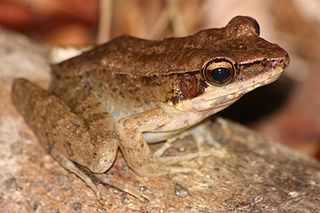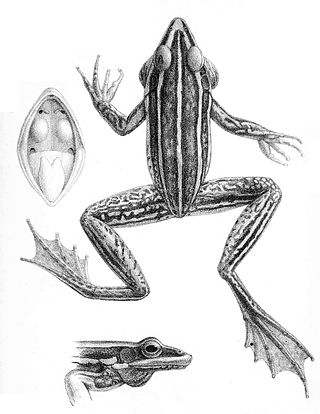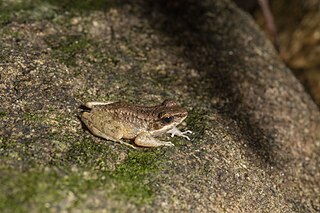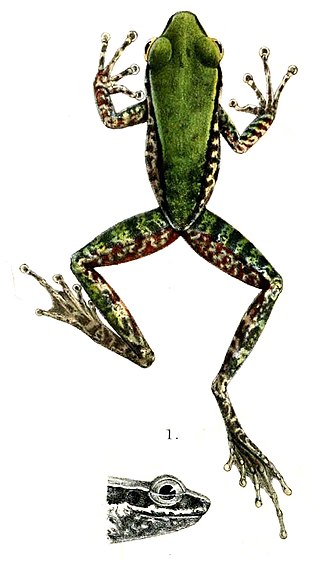
Papurana daemeli is a species of "true frog", family Ranidae. It is found in New Guinea, northern Australia, and some smaller islands. It is the only ranid frog found in Australia. In Australia, the species is restricted to the rainforest of northern Queensland and the eastern border of Arnhem Land, in the Northern Territory. In Australia, it is usually known as wood frog or sometimes as water frog. Other vernacular names are Australian wood frog, Australian bullfrog, and Arnhem rana.

Indosylvirana aurantiaca, commonly known as the golden frog, is a species of frog endemic to the Western Ghats of India. The species is also known as the Trivandrum frog, the common wood frog, or the small wood frog.
Cornufer macrops, also known as the Aresi wrinkled ground frog, is a species of frog in the family Ceratobatrachidae. The specific name macrops refers to the very large eyes of this species. It is endemic to Bougainville Island, in the Papua New Guinean part of the Solomon Islands archipelago. It is only known from the mountains of northern Bougainville Island, near Kunua, although its true range could be much wider.

The Amami tip-nosed frog is a species of frog in the family Ranidae. It is endemic to the Amami Islands, a part of the Ryukyu Islands, Japan. Specifically, it is known from the islands of Amamioshima and Tokunoshima.
Papurana garritor is a species of frog in the family Ranidae. It is endemic to New Guinea and widely distributed, found in both Indonesian and Papua New Guinean parts of the island. Common name Eilogo Estate frog has been coined for it.

Humerana oatesii is a species of frog in the family Ranidae. It is endemic to Burma. This species is only known from type series collected from "near Toungoo" in the Pegu Range. The specific name oatesii honours Eugene W. Oates, English civil servant and naturalist who collected the type series. However, the common name Toungoo frog has been proposed for it.
Odorrana supranarina is a species of frog in the family Ranidae. It is endemic to Ryukyu Archipelago, Japan, and is known from the islands of Ishigaki and Iriomote, both in the Yaeyama Group. The specific name supranarina refers to the large size of this species —at the time of the species description, it was the largest member of the so-called Rana narina complex. Common name greater tip-nosed frog has been coined for it.

Odorrana utsunomiyaorum is a species of frog in the family Ranidae. It is endemic to Ryukyu Archipelago, Japan, and is known from the islands of Ishigaki and Iriomote, both in the Yaeyama Group. The specific name utsunomiyaorum honours Taeko and Yasuaki Utsunomiya for their contributions to clarifying the amphibian fauna of the Yaeyama Group.

Hylarana, commonly known as golden-backed frogs, is a genus of true frogs found in tropical Asia. It was formerly considered highly diverse, containing around 84 to 96 valid species, but taxonomic revision resulted in a major change in the contents of the genus, and today it is recognised as containing just four species.
Papurana arfaki is a species of true frog, family Ranidae. It is widely distributed in New Guinea and also found on the Aru Islands (Indonesia). Common names Arfak Mountains frog and large river-frog have been coined for it. Its type locality is the Arfak Mountains.
Papurana attigua is a species of frog in the family Ranidae, the "true frogs". It is found in central and south Vietnam, eastern Cambodia, and southern Laos. The specific name attigua is derived from Latin attiguus meaning "neighbor". It refers to the similarity of this species to Indosylvirana milleti. The common name similar frog has been coined for this species.
Papurana aurata is a species of true frog, the family Ranidae. It is only known from the area of its type locality near Nabire, in the Indonesian province of Papua, in New Guinea. The specific name aurata is Latin and refers to the gold-like colour of adult males.

Chalcorana eschatia is a species of "true frog" in the family Ranidae. It is known from southern Thailand, but is likely to be more widespread. It was split off from Chalcorana chalconota by Robert Inger and colleagues in 2009, along with a number of other species in so-called "Rana chalconota group". The specific name eschatia, derived from the Greek word for "outskirt", refers to distribution of this species being at the edge of the geographical range of the group.
Papurana grisea is a species of true frog. It is known with certainty only from its type locality in the Went Mountains, in the Indonesian province of Papua, New Guinea. Similar frogs are widespread in New Guinea, usually above 1,200 m (3,900 ft) above sea level, as well as on the Seram Island, but their identity is uncertain; they possibly represent another, undescribed species. Common names Went Mountains frog and Montaen swamp frog have been coined for it.

Chalcorana macrops is a species of "true frog" in the family Ranidae. It is endemic to Sulawesi, Indonesia. Common name Masarang frog has been coined for it. The specific name macrops refers to the large eyes of this frog.
Papurana milneana is a species of "true frog", family Ranidae. It is endemic to Papua New Guinea where it is found in the upland areas of Milne Bay, Morobe, Northern, and Central Provinces, as well from the D'Entrecasteaux Islands and, tentatively, Louisiade Archipelago. It was originally described as a subspecies of Rana grisea, but raised to full-species status in 2007.
Papurana novaeguineae is a species of true frog, family Ranidae. It is endemic to southern New Guinea and occurs between Lake Yamur and Purari River. Common name New Guinea frog has been coined for it.

Papurana papua is a species of true frog, family Ranidae. It is endemic to New Guinea and found in the northern part of the island in both Indonesia and Papua New Guinea as well in some offshore islands. Common name Papua frog has been coined for it.
Papurana supragrisea is a species of true frog, family Ranidae. It is endemic to New Guinea, including some nearby islands. It is known with certainty only from southeastern New Guinea and from the D'Entrecasteaux Islands. However, this name has been used more broadly for a species complex that is widely distributed in the mountains of New Guinea. Common name Papua gray frog has been coined for it.

Papurana waliesa is a species of "true frogs", family Ranidae. It is endemic to Papua New Guinea where it is found in the southern Owen Stanley Range and the Pini Range in the eastern New Guinea as well as in the D'Entrecasteaux Islands. The specific name waliesa is derived from the Dobu word waliesa that means "namesake", in honor of Fred Malesa from Fergusson Island. He had greatly assisted the describers of this species during their expedition in the Milne Bay Province.











